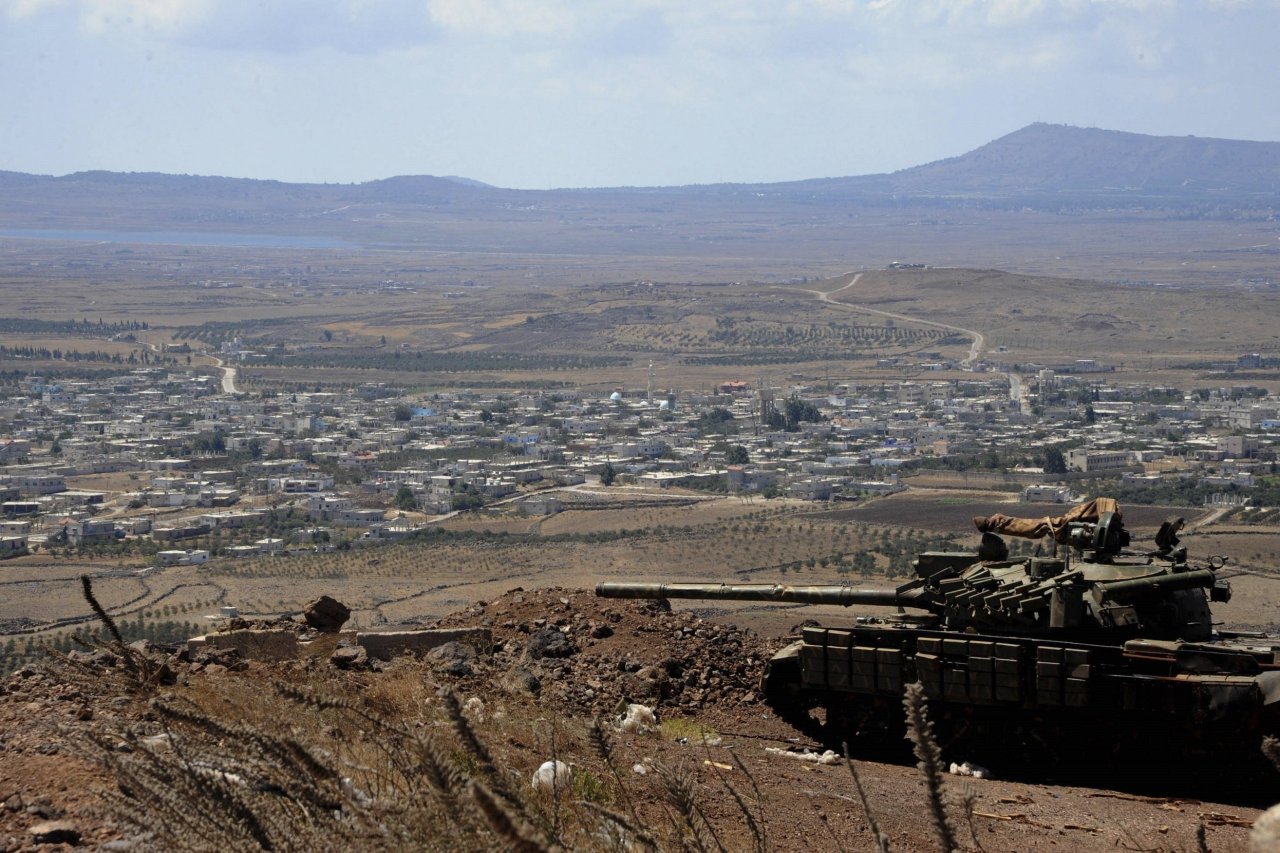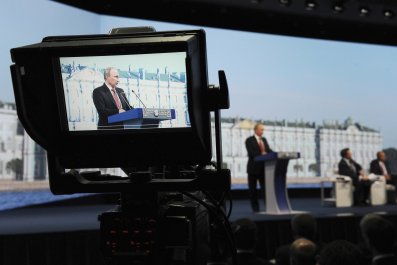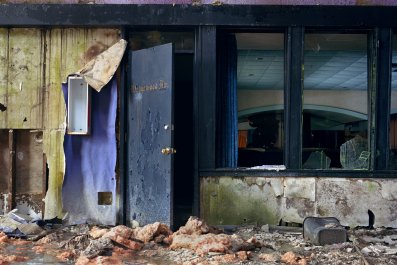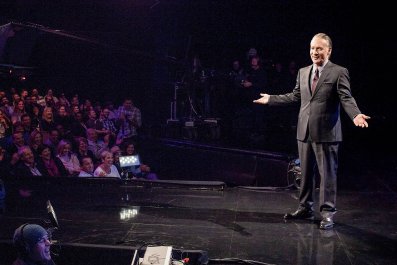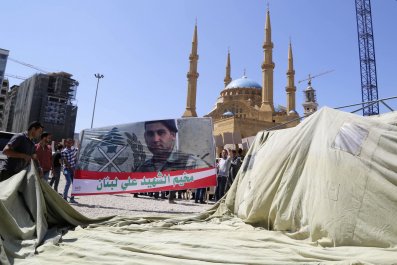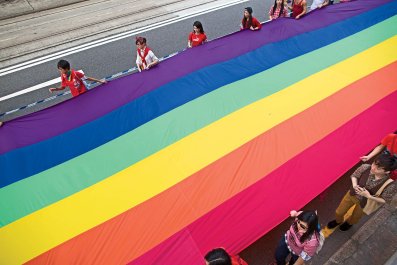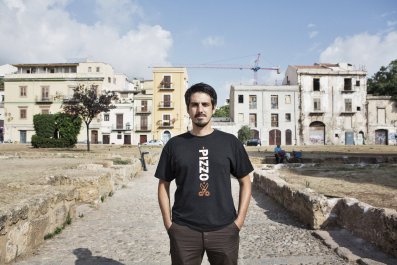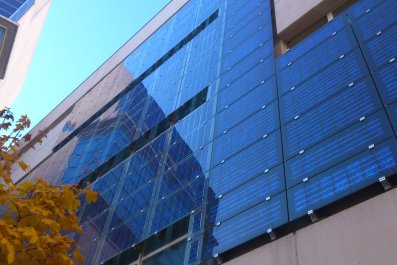A green flag waves peacefully, clearly visible through the smart fence, a camera-equipped electric apparatus surrounding a remote-controlled gate here in the Golan Heights. Next door is Camp Ziouani of the United Nations Disengagement Observer Force (UNDOF). In the distance, the faint booming sound of a constant artillery exchange can be heard. Flying a mere 150 yards away from the blue-white Israeli flag, that green banner represents a Syrian jihadist group, one of many here.
Far from where an American-led battle against the Islamic State (commonly called ISIS) is brewing, this deceptively tranquil posting, separating Israelis from Syrians, is more unstable than it has ever been. The jihadists, moderate Syrian rebels, U.N. observers from Fiji and the Philippines, Israeli farmers, and soldiers who come together here as unlikely neighbors face a volatile future.
The Syrian army, which once controlled its side of the border, no longer does. The U.N.'s presence is increasingly perilous. As the recent kidnappings have shown, the calm can end at any moment and may even drag Israel into the Syrian civil war.
The Kunetra Crossing used to be a peaceful posting. Israeli and Syrian soldiers, as well as UNDOF troops charged with observing a 1974 cease-fire agreement, would eye each other across what was then a knee-high fence. Men, women and children, mostly from Druze clans torn apart four decades ago, crossed the border through the gate daily. They would undergo a routine check on both sides, attend a family reunion or wedding across the border, then return a few days later.
No longer. No one goes through the Kunetra Crossing these days. Most of the UNDOF troops that had been posted on the Syrian side of the Golan have been moved to the Israeli side, near the Kunetra crossing. The U.N. force's Camp Foer, to which the 45 Fijian hostages were returned, was evacuated last week after heavy battles between the Syrian army and rebels.
An errant piece of shrapnel, part of the endless artillery barrage between the warring factions on the Syrian side, crossed the border recently, injuring an Israeli Defense Forces (IDF) officer. "Sometimes it's scary, but mostly I'm OK," says Dvir Ben Simchon, a 22-year-old from Tel Aviv who spent the summer as a hired hand, picking apples at an orchard belonging to an Israeli kibbutz. "The fighting got right here. I was in the nearest orchard to the border," he says.
That was on August 30, when armed men of Jabhat al-Nusra and other Islamist groups loosely affiliated with Al-Qaeda stormed the Kunetra Crossing into the neutral zone where the U.N. observers are posted. Peacekeepers from the Philippines managed to narrowly escape the battle unharmed, finding safety at Camp Ziouani on the Israeli side, where the UNDOF has moved its headquarters since the civil war in Syria made Damascus too dangerous.
A few days earlier, on August 28, the jihadists took hostage 45 Fijian U.N. observers, who were eventually released unharmed on September 11. The U.N. presence is no longer considered an impartial observer. It is targeted by the various Syrian groups, which will make for an interesting Security Council discussion in October when the UNDOF's mandate renewal will be debated. Officials from the two largest contributors of troops to the force, the Philippines and Ireland, have already expressed doubts about continuing to send troops into this danger zone.
If the U.N. were to abandon its mission here, would it make any difference? "We don't rely on the UNDOF for our security," says an IDF spokesman, Peter Lerner. But beyond that simple statement of fact, a number of Jerusalem officials I spoke with were extremely cautious when speaking about the usefulness of the U.N. force.
The UNDOF was posted to the Golan in 1974, after the war that President Hafez Assad—father of the current Syrian dictator, Bashar Assad—launched against Israel the previous year. Smarting from his defeat in that conflict, Assad meticulously kept the cease-fire line calm until his death in 2000. The U.N. filed routine reports about rare, and mostly minor, violations of the cease-fire terms. Bashar Assad also maintained the calm, until the rebellion against his rule started three years ago.
The first sign of trouble was an attempt at crossing the border in May 2011. Assad said it was a spontaneous rally by angered citizens in solidarity with the Palestinians in Israel. But Israeli officials saw the deadly incident, in which at least a dozen would-be infiltrators were killed, as a ploy to divert world and Arab opinion from the widespread unrest going on in Damascus at the time, which turned into a full-blown uprising against the regime.
"They simply jumped over the fence," Lerner says. Since then, he adds, the IDF has erected a new, higher fence equipped with cameras and motion-detection devices watching any movement along the border. The steely mesh surrounding the crossing, held up by deeply dug concrete poles, is electrified to deter any future infiltration attempts. The IDF has replaced the reserve units that had held the line with a beefed-up and battle-ready elite force.
But the main change in the Golan is on the other side of that fence.
Since the anti-Assad uprising turned into a full-blown armed war, drawing in players from the Middle East and way beyond, Damascus has lost control over the 20-mile frontier separating Israel and Syria in the Golan, which since 1974 has been known as the Purple Line.
"The Syrian army has two divisions on its side of the Golan—Division 61 south of Kunetra and Division 90 north of Kunetra," says Idan Avni, a correspondent for Israel Radio. "But Assad has more urgent battles, in Aleppo, Damascus, etc. These guys over here haven't received anything from him in months. No supplies, no arms, nothing. So they defect or surrender to the rebel side, or they simply lay down their arms and go home."
On the Syrian side of the border, the picture of what is going on is confused and constantly changing. For months, the Syrian side of the border has been controlled not by the army but by various rebel groups. "See this green flag?" says Avni, pointing to the banner across the Kunetra Crossing. "I'm not even sure which Islamist group this flag belongs to, there are so many. A few weeks ago, there was a different green flag there."
Kunetra and the border areas south of it are controlled by jihadists that are dominated by Jabhat al-Nusra. Further north, more moderate anti-Assad groups, like the Free Syrian Army (FSA), hold territory, as do members of the Druze sect.
"I was born Syrian, so I'm Syrian," says Ahmad Farhat, a 63-year-old Druze man from the village of Boukata, which has been controlled by Israel since he was in his 20s. Farhat has spent most of his life as a math teacher in the Israeli education system. "My grandmother is in Lebanon, and my aunt is in Daliyat el-Carmel" in Israel, he says.
The Druze are mostly loyal to their own sect, and the Israelis—as well as the U.N.—consider the areas they and the secular FSA control more tranquil and less dangerous than the al-Nusra-controlled south, where the U.N. observers were kidnapped.
After being held by the jihadists for two weeks, the 45 Fijians were handed over to the UNDOF and were debriefed and medically assessed at Camp Foar, where the Fijian battalion is stationed on the safer, northern side of the Golan. But on the Syrian side, no area is seen as safe any longer.
"It's always bad when people are killed, be they Arab, Jews or anyone, especially children," says Yehuda Harel, 79, of the Golan Research Institute in Katzrin, the largest Israeli town on the plateau. A former Knesset member, Harel was one of the founders of the Merom Golan kibbutz and moved there three days after the end of 1967's Six-Day War, in which Israel seized the strategic plateau of the Golan Heights from Assad's Syria.
"These guys wearing black pose an existential threat to the Arab world, but not for us," Harel says. "I live right on the border, but as of yet I haven't been inside a bomb shelter." He says the Syrian army has been more dangerous for Israel than the current jihadists. But neither he nor anyone on either side of the Golan border can confidently predict the future.
But the Golan is no longer Israel's calmest frontier, complete with picturesque orchards, wineries and cattle herders. The granite rocks strewn across the plateau, left over from lava eruptions of eons past, are a timely reminder that volcanoes may become dormant, but eruptions can occur when you least expect them.



